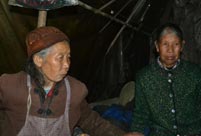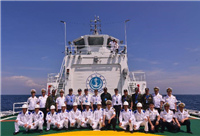

SEOUL, March 17 -- South Korea's Defense Ministry said on Tuesday that it will decide on whether to deploy the advanced U. S. missile defense system on the Korean Peninsula based "on its own judgment."
Defense Ministry spokesman Kim Min-seok told a press briefing that though neighboring countries can have their own positions on the Terminal High-Altitude Area Defense (THAAD) deployment by the U.S. Forces Korea, the neighbors "should not try to exercise their influence on our national defense and security policy."
The advanced U.S. missile defense system, developed by the U.S.- based Lockheed Martin, was designed to intercept ballistic missiles at an altitude of 40-150 km.
The United States has expressed its hope to deploy the THAAD battery on the Korean Peninsula to better fend off what it claimed nuclear and missile threats from the Democratic People's Republic of Korea (DPRK).
"If the U.S. government asks South Korea for consultations after deciding on the THAAD deployment by the U.S. Forces Korea, our Defense Ministry plans to make a decision and judgment on our own after considering military effectiveness and national security interests," said Kim.
The spokesman said the THAAD deployment came from the perspectives of deterrence and response to the DPRK's nuclear and missile threats, which should be eliminated.
Asked whether to purchase the THAAD system, Kim said South Korea "never has any plan to purchase the THAAD," noting that the country only has a plan to establish its own missile defense system called Korea Air and Missile Defense (KAMD).
His comments indicated South Korea's existing position on the THAAD deployment, or "three Nos," - No Request, No consultation and No decision. It means that there have been no request from the United States and no consultations between Seoul and Washington over the issue, so no decision has been made yet.
But, if Washington calls on Seoul to deploy the U.S. missile defense system on the Korean Peninsula, South Korea is highly likely to accept the proposal though it may refuse to purchase the expensive THAAD system.
South Korean Defense Minister Han Min-koo told lawmakers in October 2014 that if the THAAD was deployed under situations that South Korea had a limited available tool to respond to nuclear and missile threats from the DPRK, the THAAD would "help our security and defense."
As the THAAD has a wide range of defense capability, it would contribute much to defending South Korea and would become assets of the U.S. Forces Korea rather than the South Korean military, the minister said.
The South Korean military has a plan to develop its own KAMD system aimed at shooting down missiles at an altitude of about 40 km. It is lower in altitude than the THAAD capable of intercepting missiles at an altitude of 40-150 km.
South Korea has said that it would develop the KAMD that is focusing on the terminal-phase, low-altitude missile defense targeting the DPRK missiles. Lawmakers of the main opposition New Politics Alliance for Democracy said that it would be "meaningless " to discuss the THAAD deployment on the Korean Peninsula as the THAAD aims to intercept an intercontinental ballistic missile ( ICBM) that should be shot down at a higher altitude.
Ruling Saenuri Party lawmakers have recently requested the THAAD deployment as U.S. Ambassador Mark Lippert was slashed in his face and hand by a South Korean activist. Speculations emerged that South Korea could face disadvantage in diplomacy with the United States due to the incident.
One THAAD battery is reportedly composed of six mobile launchers and 48 missiles as well as airborne radar and firing control system. A battery is valued at about 2 trillion won (1.8 billion U.S. dollars). The radar of forward-based mode has a maximum detectable range of 2,000 km.
It would place financial burden for the South Korean government to purchase the THAAD system for itself. South Korea announced a plan in June 2014 to develop its indigenous long-range surface-to- air missile (L-SAM). About 1 trillion won was earmarked for the development alone.
More defense budgets will be spent on developing and producing five reconnaissance satellites to enhance the information- collecting capability of its own missile defense system. The military will upgrade its PAC-2 missiles to Lockheed Martin's PAC- 3 and develop medium-range surface-to-air (M-SAM) missiles as part of the KAMD.
South Korean Vice Defense Minister Baek Seung-joo said in an interview with Xinhua last week that the THAAD system is "very expensive." It would be burdensome for the U.S. government to deploy the THAAD by the U.S. Forces Korea due to its long-standing fiscal and trade deficits.
 J-11 fighters in air exercise
J-11 fighters in air exercise Beauties dancing on the rings
Beauties dancing on the rings Attendants-to-be join Mr. & Miss Campus Contest
Attendants-to-be join Mr. & Miss Campus Contest Beijing's toughest anti-smoking law takes effect
Beijing's toughest anti-smoking law takes effect Family lives in cave for about 50 years in SW China
Family lives in cave for about 50 years in SW China PLA soldiers operating vehicle-mounted guns in drill
PLA soldiers operating vehicle-mounted guns in drill Blind carpenter in E China's Jiangxi
Blind carpenter in E China's Jiangxi China hosts overseas disaster relief exercise for the first time
China hosts overseas disaster relief exercise for the first time 20 pairs of twins who will become flight attendants in Sichuan
20 pairs of twins who will become flight attendants in Sichuan Obama is sowing discontent in S.China Sea
Obama is sowing discontent in S.China Sea Rescuers work through night to reach cruise ship survivors
Rescuers work through night to reach cruise ship survivors Driving through limbo
Driving through limbo Facing down MERS
Facing down MERSDay|Week